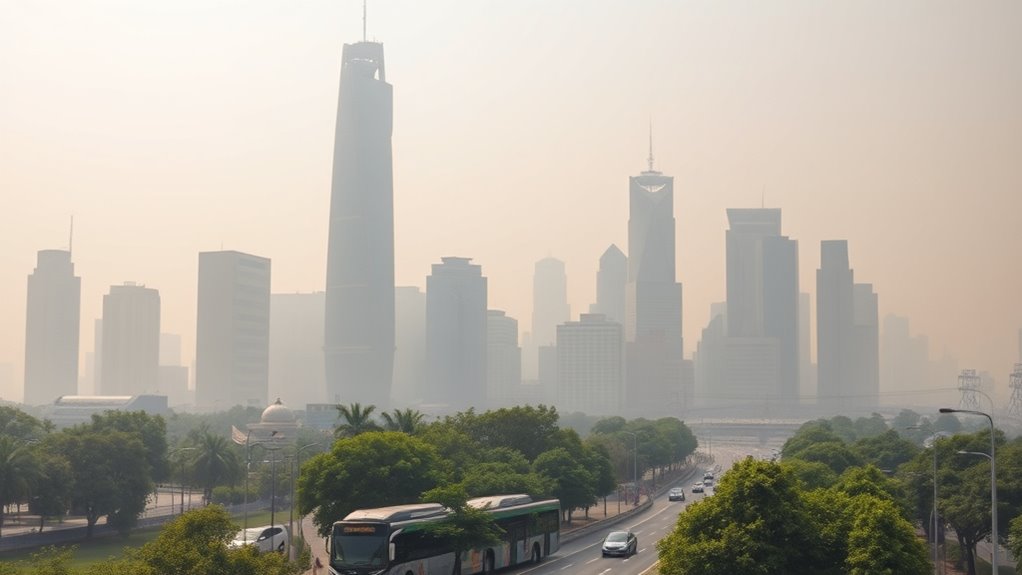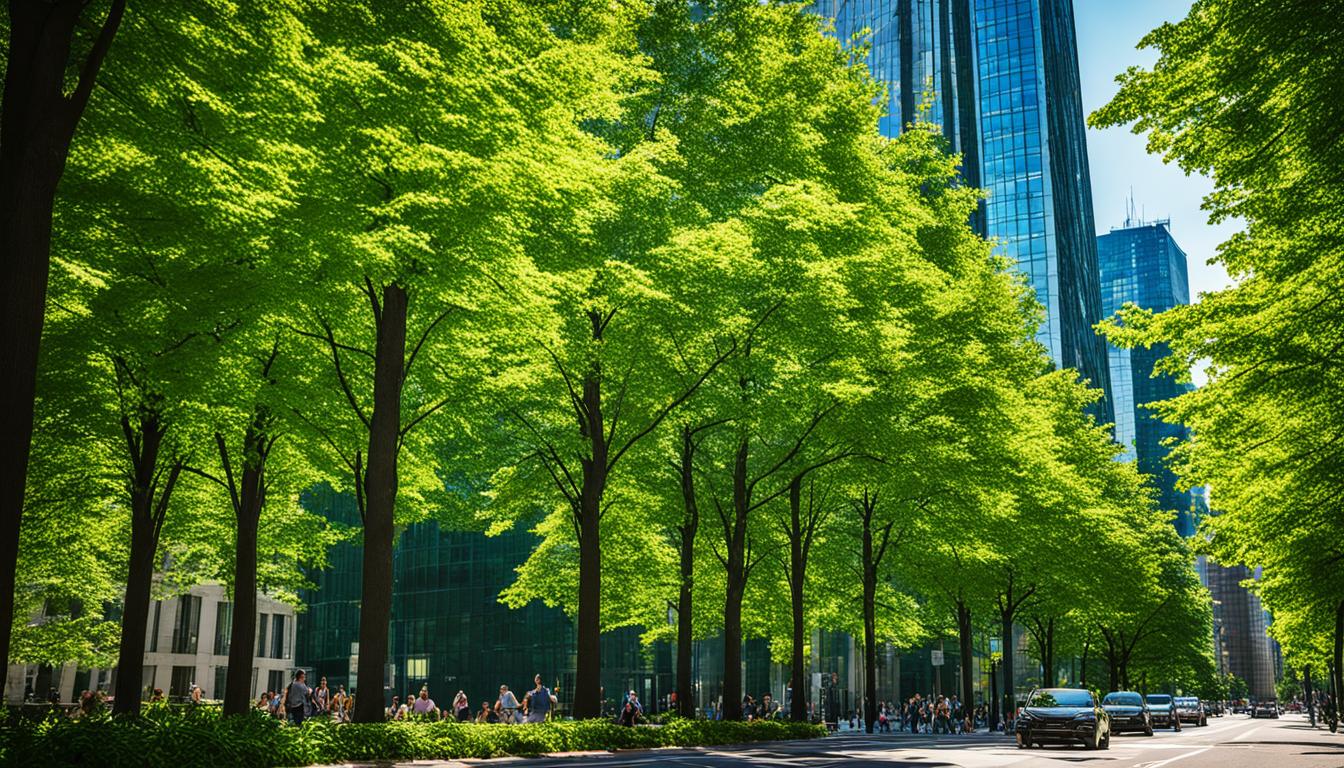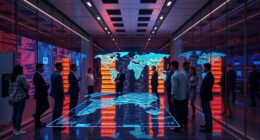To help clear the air in 2025’s cities, you can support urban planning efforts that prioritize green spaces, sustainable transportation, and zoning policies. Engage in community initiatives that raise awareness about pollution sources and encourage eco-friendly habits like biking or using public transit. By understanding these strategies, you’ll see how city planning and public action work together to improve air quality and protect health — and there’s more to discover about making urban living healthier.
Key Takeaways
- Integrating green infrastructure like urban forests and green roofs can significantly filter pollutants and improve air quality.
- Strategic urban planning, including zoning and transportation policies, reduces emissions from traffic and industrial sources.
- Promoting public awareness and individual actions, such as reducing vehicle use and waste burning, support cleaner air efforts.
- Developing sustainable urban designs encourages walking, biking, and cleaner transit options to lower pollution levels.
- Transparent communication and community engagement foster support for policies aimed at reducing air pollution in cities.

Air pollution remains one of the most pressing environmental challenges today, directly impacting your health and the planet’s future. As cities grow and industries expand, the quality of the air you breathe becomes increasingly compromised. Tackling this issue requires a combination of strategic urban planning and heightened public awareness. Urban planning plays a vital role because it shapes the physical landscape of your city, influencing traffic flow, industrial zones, green spaces, and transportation infrastructure. When city planners prioritize sustainable designs—such as creating pedestrian-friendly zones, expanding public transit options, and incorporating green buffers—they help reduce emissions that contribute to poor air quality. These measures encourage you to walk, bike, or use cleaner transit options, which in turn lessen reliance on polluting vehicles. Thoughtful urban planning also involves zoning policies that separate industrial activities from residential areas, minimizing residents’ exposure to harmful pollutants. When your city invests in green infrastructure—like parks, urban forests, and green roofs—it not only improves air filtration but also fosters a healthier environment overall.
Beyond infrastructure, raising public awareness is equally essential. When you understand the sources and health impacts of air pollution, you’re more likely to support and participate in initiatives that promote cleaner air. Public awareness campaigns can inform you about simple actions—such as reducing vehicle idling, avoiding burning waste, or choosing eco-friendly products—that can collectively make a difference. Education programs in schools and community outreach efforts help reinforce the importance of individual contributions to air quality. When you’re aware of pollution peaks during certain times or weather conditions, you can modify your activities accordingly, like limiting outdoor exercise during high smog days. Increased awareness also encourages community engagement, motivating residents to advocate for policies that prioritize cleaner transportation options, stricter emission standards, and more green spaces.
Combining effective urban planning with robust public awareness creates a powerful synergy. When city officials are transparent about pollution levels and actively involve communities in decision-making, change becomes more tangible. You become an informed participant rather than a passive observer. Together, these approaches can lead to policies that promote cleaner air, healthier lifestyles, and resilient cities. Ultimately, your active involvement and understanding of urban design principles make a difference. By supporting sustainable development and staying informed about air quality issues, you contribute to creating a city where clean air is not just an ideal but a reality. Tackling air pollution in 2025’s cities depends on your awareness and the strategic planning that shapes your environment—both essential steps toward a healthier future for everyone.
Frequently Asked Questions
How Does Air Pollution Directly Affect Mental Health?
Air pollution directly impacts your mental health by increasing anxiety, depression, and stress levels. It can also cause cognitive decline over time, making it harder to focus and process information. Breathing polluted air triggers inflammation and oxidative stress, which harm your brain’s functions. As pollution worsens, you might notice mood swings and decreased mental clarity, so protecting yourself from exposure is essential for maintaining your overall mental well-being.
What Are the Long-Term Economic Impacts of Urban Air Pollution?
Imagine a future where cities like yours face economic costs from ongoing air pollution. Long-term, these costs include increased healthcare expenses, reduced worker productivity, and strained public resources. You’ll need strong policy implications, such as stricter emissions standards, to curb these impacts. If ignored, your city could see a decline in economic growth and quality of life, making it essential to act now for a healthier, more sustainable urban environment.
Can Individual Actions Significantly Reduce City Air Pollution?
Yes, your personal habits and participation in community initiatives can profoundly reduce city air pollution. By choosing public transportation, biking, or walking instead of driving, you lower emissions. Supporting and joining community efforts to plant trees or advocate for cleaner policies amplifies your impact. Every small change adds up, and collective action can lead to cleaner air, healthier urban environments, and a more sustainable future for everyone.
How Do Air Pollution Levels Vary Seasonally Across Different Cities?
You’ll notice air pollution levels fluctuate seasonally across different cities, with peak pollution often occurring during winter due to increased heating and stagnant air. Seasonal variation causes pollution hotspots, especially in urban areas with high traffic or industrial activity. In summer, improved air circulation can reduce pollution, but heatwaves may worsen it locally. Staying aware of these patterns helps you plan outdoor activities and advocate for policies to address seasonal pollution spikes.
What Role Do Emerging Technologies Play in Future Air Quality Management?
Sure, because who wouldn’t want their city to be monitored by tiny robot spies, right? Emerging technologies play a huge role in air quality management by integrating sensors that track pollution in real time, and data analytics that turn that chaos into actionable insights. You can expect smarter, faster responses to pollution spikes, making your city cleaner and healthier—if only your smartphone could also clear the air!
Conclusion
By now, you realize that tackling air pollution isn’t just about new tech or policies—it’s about your daily choices and collective action. Imagine walking through a city where the air is as clear as a spring day, with children’s laughter echoing like a distant carol. Just like the heroes of old, you can be part of this transformation. If we act now, 2025 could be the year we breathe freely, turning our cities into thriving, healthy havens once more.








